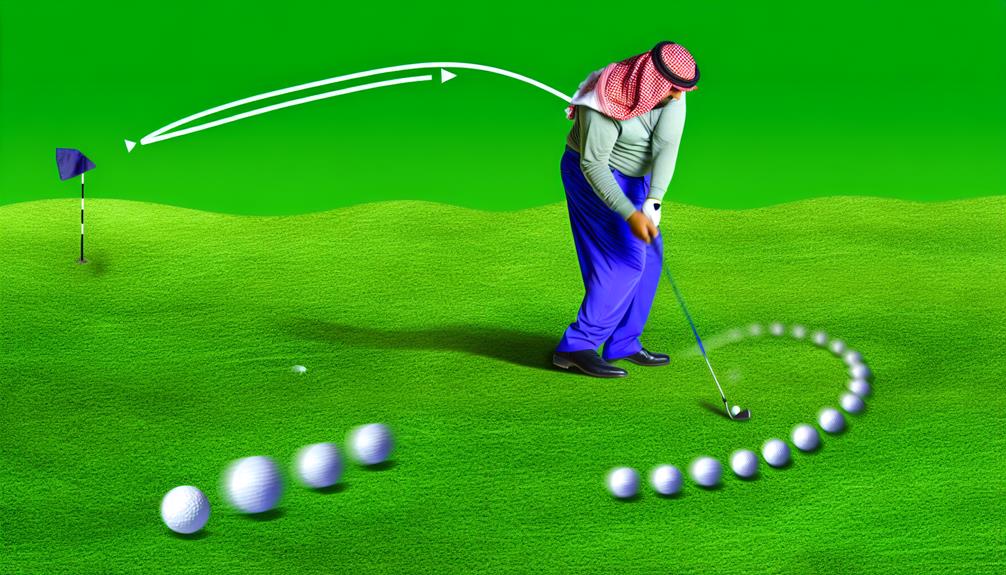In the world of golf, where tranquility often meets intensity, few situations can be as nerve-wracking as having to putt on fast greens. You've probably found yourself in this predicament, the hole seems miles away and the green, slicker than a sheet of ice.
But don't let the panic set in. There are quick strategies, techniques really, that can turn this challenging aspect of the game into an opportunity for scoring.
Interested to know how to master these greens and transform your game? Well, you're about to find out.
Understanding Fast Golf Greens
To truly master the game of golf, you'll need to understand the unique challenges that come with playing on fast greens and how they differ from other surfaces.
Fast greens, often seen in professional tournaments, are slick and quick due to meticulous green maintenance. This involves frequent mowing, rolling, and minimal watering to achieve a firm, tight surface.
Your equipment selection can make or break your game on fast greens. A softer golf ball can provide better control, while a putter with a heavier head can improve your stroke consistency. It's essential to have equipment that suits the course conditions, and fast greens require a specialized approach.
Understanding the ball's behavior on fast greens is crucial. The ball rolls farther and faster, so you'll need to adjust your putting strength. Additionally, the break – the curve of the golf ball as it slows down – is often more pronounced on fast greens. You'll have to read the green accurately and adjust your aim accordingly.
Mastering the Stroke Technique
Mastering your stroke technique is arguably the most critical aspect of playing on fast greens, requiring a delicate balance between control and power. The grip dynamics you apply to your club play a crucial role in this.
The grip pressure should be firm enough to maintain control, yet light enough to allow flexibility and fluidity in the swing. Too tight, and you risk a rigid stroke, too loose, and you might lose control of the club.
Club selection is also vital in mastering your stroke on fast greens. Generally, a putter with a heavier head can help maintain a smoother, steadier stroke. It reduces the chances of your hands and wrists becoming too active, which can lead to inconsistencies in your stroke path and pace.
Finally, remember that the speed of your stroke should be dictated by the size of your backswing and not the force you apply. A longer backswing for longer putts, and a shorter one for shorter putts. This method ensures a smoother acceleration through the ball, rather than a forced hit, offering you the finesse needed on fast greens.
Master these techniques, and you'll find yourself more confident and capable on fast greens.
Adjusting Putting Speed and Direction
After getting a firm grip on your stroke technique, it's important to focus on adjusting your putting speed and direction to navigate the quick pace of fast greens effectively. This adjustment is critical in ensuring the ball goes into the hole with minimum strokes.
A significant factor to consider is the Ball Weight Impact. A heavier ball tends to roll slower than a lighter one on the same surface, so you'll need to hit it harder on fast greens. However, be cautious not to overdo it as you might end up overshooting the hole.
Equipment Selection is equally crucial in determining your putting speed and direction. A putter with a heavier head can provide better control over your strokes, especially on speedy greens. It offers a steadier swing, reducing the risk of the ball veering off its intended path.
To refine your direction control, practice aiming at a specific point on the green rather than the hole itself. This technique, known as 'spot putting', can help fine-tune your direction adjustment, particularly on fast greens.
Importance of Pre-Putt Routine
Establishing a consistent pre-putt routine is paramount in achieving optimal results on the golf course, particularly when dealing with fast greens. This routine serves two key roles: mental preparation and confidence building.
Mental preparation is the first step. Before you even address the ball, visualize the putt. Assess the speed and direction of the green. Envision the ball's path and the force you'll need to apply. This cognitive exercise not only prepares your body for the physical act of putting but also primes your mind for success.
Confidence building is the second crucial component of your pre-putt routine. Remember, confidence isn't about arrogance—it's about belief in your ability to execute the putt. Repetition breeds familiarity, and familiarity breeds confidence. By committing to a specific routine before each putt, you're reinforcing your self-belief.
Each golfer's routine will be unique, but crucial elements can include practice swings, deep breaths, or a particular grip. The goal isn't to mimic someone else's routine, but to develop one that calms your nerves, focuses your mind, and gives you faith in your skills. It's an essential tool in your arsenal when tackling fast greens.
Perfecting Green Reading Skills
Building on your pre-putt routine, it's crucial to perfect your green reading skills to tackle fast greens effectively. This process involves honing your ability to interpret the subtle nuances of the green, such as slope and grain direction. The key lies in effective visual cues utilization.
Firstly, notice the overall layout of the green. Look for any obvious slopes or undulations that might affect the trajectory of your putt. Look at the color of the grass, too. Darker shades usually indicate the direction of the grain, which can slow down your putt.
Next, get low to the ground to view the finer details, such as subtle breaks or changes in grain. This bird's-eye view yields crucial information that can significantly influence your putt's line and speed.
Mental visualization techniques are also a crucial part of green reading. Visualize the putt's path, from the ball to the hole, considering the speed and break. Picture the ball's journey, rolling along the predicted line and into the hole.

